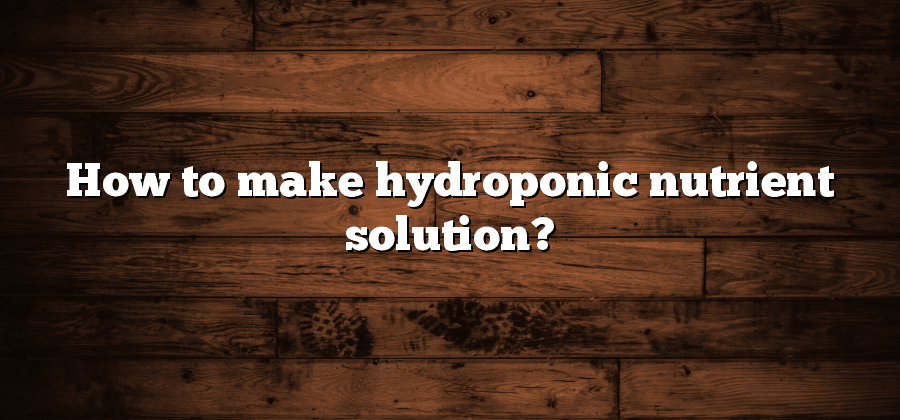Ingredients for Hydroponic Nutrient Solution
In order to optimize growth and yield in hydroponic systems, it is essential to provide plants with a well-balanced and nutrient-rich solution. The ingredients for hydroponic nutrient solution may vary depending on the specific needs of the plants being cultivated. However, there are some fundamental elements that are indispensable in any nutrient solution.
Firstly, it is crucial to provide macronutrients such as nitrogen (N), phosphorus (P), and potassium (K), commonly referred to as NPK. These macronutrients are essential for overall plant development, with nitrogen aiding in leaf and stem growth, phosphorus supporting root establishment and flower production, and potassium promoting disease resistance and overall plant vigor. Additionally, secondary macronutrients, including calcium (Ca), magnesium (Mg), and sulfur (S), play a vital role in facilitating various plant functions and should not be overlooked. Lastly, essential micronutrients, such as iron (Fe), manganese (Mn), and zinc (Zn), are required in smaller quantities but are equally important for a plant’s proper growth and development.
Choosing the Right Nutrient Solution Formula
When it comes to choosing the right nutrient solution formula for your hydroponic system, there are several factors to consider. One of the most important factors is the specific needs of your plants. Different plants have different nutrient requirements, so it’s crucial to select a formula that matches the nutritional needs of the plants you are growing.
Another factor to consider is the growth stage of your plants. Plants have different nutrient requirements at different stages of growth. For example, during the vegetative stage, plants require higher levels of nitrogen to support leaf and stem development. On the other hand, during the flowering stage, plants require higher levels of phosphorus and potassium to support flower and fruit production. Therefore, it is important to choose a nutrient solution formula that is tailored to the growth stage of your plants, ensuring they receive the right balance of nutrients at each stage.
Understanding the Role of Macro-nutrients
Macro-nutrients are a crucial component of hydroponic nutrient solutions. These essential elements, required in larger quantities by plants, play a vital role in promoting healthy growth and optimal development. The three primary macro-nutrients are nitrogen (N), phosphorus (P), and potassium (K), commonly referred to as NPK.
Nitrogen (N) is an essential building block for plants, contributing to the development of leaves, stems, and overall vegetative growth. It is responsible for producing chlorophyll, the pigment that aids in photosynthesis. Phosphorus (P) facilitates the transfer of energy throughout the plant, promoting root development and flower formation. Lastly, potassium (K) is crucial for enzyme activation, osmoregulation, and the transportation of nutrients and water within the plant. It also enhances the plant’s resistance to stress and diseases. Finding the right balance of these macro-nutrients in your hydroponic solution is key to ensuring healthy plant growth and maximum yield.
Understanding the Role of Micro-nutrients
Micro-nutrients are essential elements that are required by plants in small amounts. Although they are needed in lesser quantities compared to macro-nutrients, their role in plant growth and development should not be underestimated. Micro-nutrients include elements such as iron, manganese, zinc, copper, molybdenum, boron, and chlorine, among others.
Each micro-nutrient plays a specific role in the plant’s physiological processes. For example, iron is crucial for chlorophyll synthesis, which is vital for photosynthesis and overall plant health. Manganese aids in enzyme activation and helps with the breakdown of carbohydrates, while zinc is involved in the synthesis of plant hormones and enzyme systems. Copper plays a role in energy transfer and the formation of lignin, a component of cell walls. Molybdenum is involved in nitrogen fixation and helps with the conversion of nitrogen into plant-usable forms. Boron assists in cell division and the movement of sugars within the plant. Lastly, chlorine plays a part in stomatal regulation and maintaining proper cell osmotic pressure.
By understanding the specific roles of micro-nutrients, hydroponic growers can ensure that their nutrient solutions contain the right balance of these essential elements. However, it is important to note that the concentrations of micro-nutrients in the nutrient solution should be carefully managed, as excessive or insufficient levels can lead to nutrient imbalances and affect the overall health and productivity of the plants. Therefore, accurately measuring and adjusting the micro-nutrient levels in the nutrient solution is crucial for optimal plant growth and development in a hydroponic system.
Calculating the Correct Nutrient Solution Strength
Properly calculating the correct nutrient solution strength is crucial for successful hydroponic gardening. The nutrient solution strength refers to the concentration of nutrients in the water that is used to feed the plants. This calculation is important because both an insufficient and excessive nutrient concentration can have detrimental effects on plant growth.
To calculate the correct nutrient solution strength, it is necessary to consider the specific needs of the plants being grown. This can be determined by researching the optimal nutrient requirements for the particular plant species. These requirements often differ depending on the growth stage of the plants, so it is essential to take this into account when calculating the nutrient solution strength. Additionally, the water quality and pH level should also be considered as they can impact nutrient availability for the plants. By carefully assessing all these factors, it is possible to find the balance and create an optimal nutrient solution strength for hydroponic gardening.






